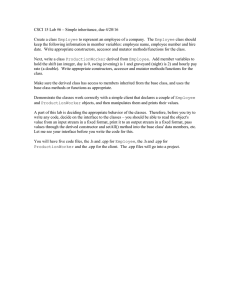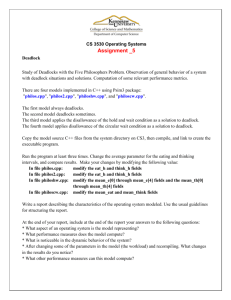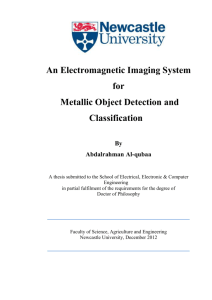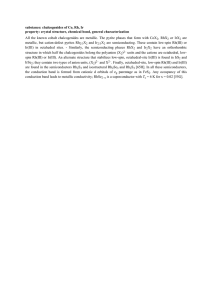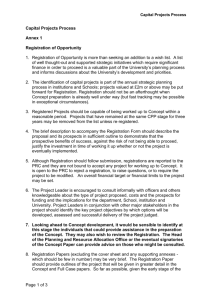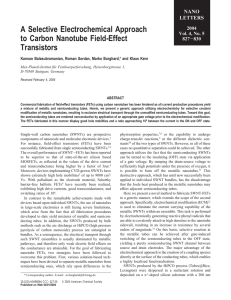substance: chalcogenides of Cr, Mo, W
advertisement
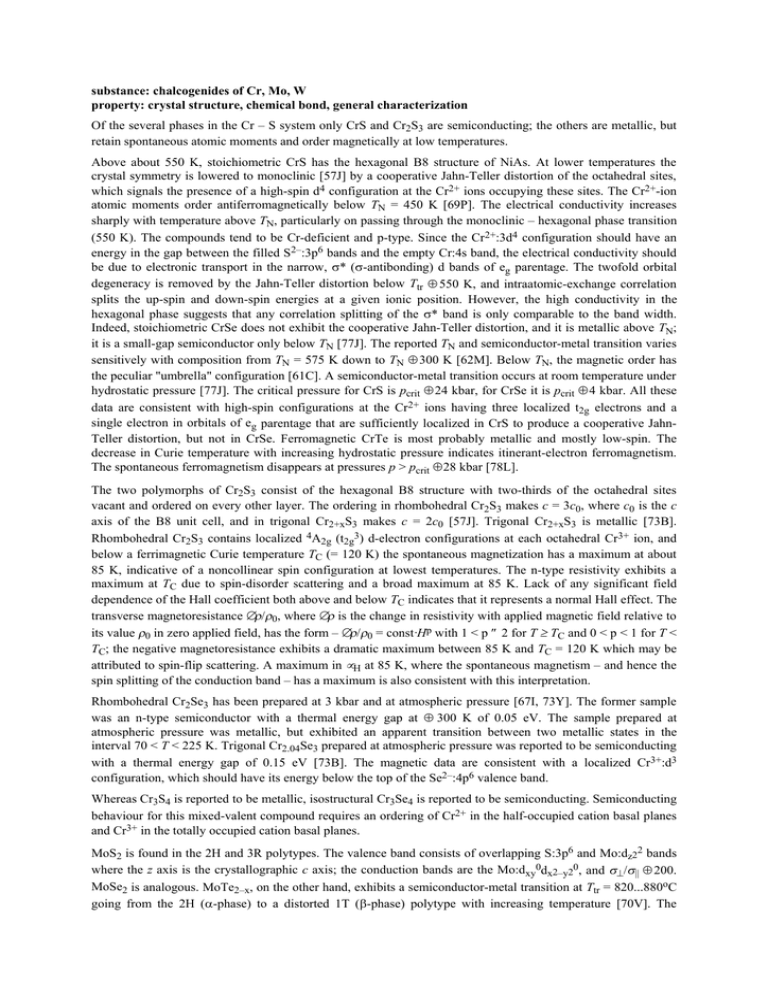
substance: chalcogenides of Cr, Mo, W property: crystal structure, chemical bond, general characterization Of the several phases in the Cr – S system only CrS and Cr2S3 are semiconducting; the others are metallic, but retain spontaneous atomic moments and order magnetically at low temperatures. Above about 550 K, stoichiometric CrS has the hexagonal B8 structure of NiAs. At lower temperatures the crystal symmetry is lowered to monoclinic [57J] by a cooperative Jahn-Teller distortion of the octahedral sites, which signals the presence of a high-spin d4 configuration at the Cr2+ ions occupying these sites. The Cr2+-ion atomic moments order antiferromagnetically below TN = 450 K [69P]. The electrical conductivity increases sharply with temperature above TN, particularly on passing through the monoclinic – hexagonal phase transition (550 K). The compounds tend to be Cr-deficient and p-type. Since the Cr 2+:3d4 configuration should have an energy in the gap between the filled S2–:3p6 bands and the empty Cr:4s band, the electrical conductivity should be due to electronic transport in the narrow, σ* (σ-antibonding) d bands of eg parentage. The twofold orbital degeneracy is removed by the Jahn-Teller distortion below Ttr ≈ 550 K, and intraatomic-exchange correlation splits the up-spin and down-spin energies at a given ionic position. However, the high conductivity in the hexagonal phase suggests that any correlation splitting of the σ* band is only comparable to the band width. Indeed, stoichiometric CrSe does not exhibit the cooperative Jahn-Teller distortion, and it is metallic above TN; it is a small-gap semiconductor only below TN [77J]. The reported TN and semiconductor-metal transition varies sensitively with composition from TN = 575 K down to TN ≈ 300 K [62M]. Below TN, the magnetic order has the peculiar "umbrella" configuration [61C]. A semiconductor-metal transition occurs at room temperature under hydrostatic pressure [77J]. The critical pressure for CrS is pcrit ≈ 24 kbar, for CrSe it is pcrit ≈ 4 kbar. All these data are consistent with high-spin configurations at the Cr2+ ions having three localized t2g electrons and a single electron in orbitals of eg parentage that are sufficiently localized in CrS to produce a cooperative JahnTeller distortion, but not in CrSe. Ferromagnetic CrTe is most probably metallic and mostly low-spin. The decrease in Curie temperature with increasing hydrostatic pressure indicates itinerant-electron ferromagnetism. The spontaneous ferromagnetism disappears at pressures p > pcrit ≈ 28 kbar [78L]. The two polymorphs of Cr2S3 consist of the hexagonal B8 structure with two-thirds of the octahedral sites vacant and ordered on every other layer. The ordering in rhombohedral Cr2S3 makes c = 3c0, where c0 is the c axis of the B8 unit cell, and in trigonal Cr2+xS3 makes c = 2c0 [57J]. Trigonal Cr2+xS3 is metallic [73B]. Rhombohedral Cr2S3 contains localized 4A2g (t2g3) d-electron configurations at each octahedral Cr3+ ion, and below a ferrimagnetic Curie temperature TC (= 120 K) the spontaneous magnetization has a maximum at about 85 K, indicative of a noncollinear spin configuration at lowest temperatures. The n-type resistivity exhibits a maximum at TC due to spin-disorder scattering and a broad maximum at 85 K. Lack of any significant field dependence of the Hall coefficient both above and below TC indicates that it represents a normal Hall effect. The transverse magnetoresistance ∆ρ/ρ0, where ∆ρ is the change in resistivity with applied magnetic field relative to its value ρ0 in zero applied field, has the form – ∆ρ/ρ0 = const·Hp with 1 < p ≤ 2 for T ≥ TC and 0 < p < 1 for T < TC; the negative magnetoresistance exhibits a dramatic maximum between 85 K and TC = 120 K which may be attributed to spin-flip scattering. A maximum in µH at 85 K, where the spontaneous magnetism – and hence the spin splitting of the conduction band – has a maximum is also consistent with this interpretation. Rhombohedral Cr2Se3 has been prepared at 3 kbar and at atmospheric pressure [67I, 73Y]. The former sample was an n-type semiconductor with a thermal energy gap at ≈ 300 K of 0.05 eV. The sample prepared at atmospheric pressure was metallic, but exhibited an apparent transition between two metallic states in the interval 70 < T < 225 K. Trigonal Cr2.04Se3 prepared at atmospheric pressure was reported to be semiconducting with a thermal energy gap of 0.15 eV [73B]. The magnetic data are consistent with a localized Cr3+:d3 configuration, which should have its energy below the top of the Se2–:4p6 valence band. Whereas Cr3S4 is reported to be metallic, isostructural Cr3Se4 is reported to be semiconducting. Semiconducting behaviour for this mixed-valent compound requires an ordering of Cr2+ in the half-occupied cation basal planes and Cr3+ in the totally occupied cation basal planes. MoS2 is found in the 2H and 3R polytypes. The valence band consists of overlapping S:3p6 and Mo:dz22 bands where the z axis is the crystallographic c axis; the conduction bands are the Mo:dxy0dx2–y20, and σ⊥/σ|| ≈ 200. MoSe2 is analogous. MoTe2–x, on the other hand, exhibits a semiconductor-metal transition at Ttr = 820...880oC going from the 2H (α-phase) to a distorted 1T (β-phase) polytype with increasing temperature [70V]. The distortion consists of Mo-atom antiferroelectric displacements parallel to the c axis [66B]. The 1T polytype can be quenched to room temperature; this metastable phase is stable to nearly 750 K. Mo2.06S3 exhibits two phase transitions, which makes its physical properties complex [70D]. The 3R and 2H polytypes of WS2 and WSe2 are similar to the molybdenum analogues. Orthorhombic WTe2 is a layer structure differing from the 1T polytype by (1) hc stacking rather than hh stacking of the anion layers and (2) W displacement within the layers giving rise to zig-zag W chains having W – W separations of 2.861 Å [66B]. These displacements are not strong enough to split the 5d bands, so the compound is semimetallic with a band overlap of 0.05 eV and a conduction-band edge 0.075 eV above a broad Te:5p 6 band [66K, 72A]. References: 57J 61C 62M 66B 66K 67I 69P 70D 70V 72A 73B 73Y 77J 78L Jellinek, F.: Acta Crystallogr. 10 (1957) 620. Corliss, L. M., Elliott, N., Hastings, J. M., Sass, R. L.: Phys. Rev. 122 (1961) 1402. Masumoto, K., Hihara, T., Kamigaichi, T.: J. Phys. Soc. Jpn. 17 (1962) 1209. Brown, B. E.: Acta Crystallogr. 20 (1966) 268. Kabashima, S.: J. Phys. Soc. Jpn. 21 (1966) 945. Ivanova, V. A., Abdinov, D. Sh., Aliev, G. M.: Phys. Status. Solidi 24 (1967) K145. Popma, T. J. A., Van Bruggen, C. F.: J. Inorg. Nucl. Chem. 31 (1969) 73. DeJonge, R., Popma, T. J. A., Wiegers, G. A., Jellinek, F.: J. Solid State Chem. 2 (1970) 188. Van Bruggen, C. F., Vellinga, M. H., Haas, C.: J. Solid State Chem. 2 (1970) 303. AlHilli, A. A., Evans, B. L.: J. Cryst. Growth 15 (1972) 93. Babot, D., Chevreton, M.: J. Solid State Chem. 8 (1973) 166. Yuzuri, M.: J. Phys. Soc. Jpn. 35 (1973) 1252. Joshi, D. K., Karunakaran, C., Vaidya, S. N., Karkhanavala, M. D.: Mater. Res. Bull. 12 (1977) 1111. Lambert-Andron, B., Urazhdankina, N. P., Vettier, C.: J. Phys. (Paris) Lett. 39 (1978) 43.
